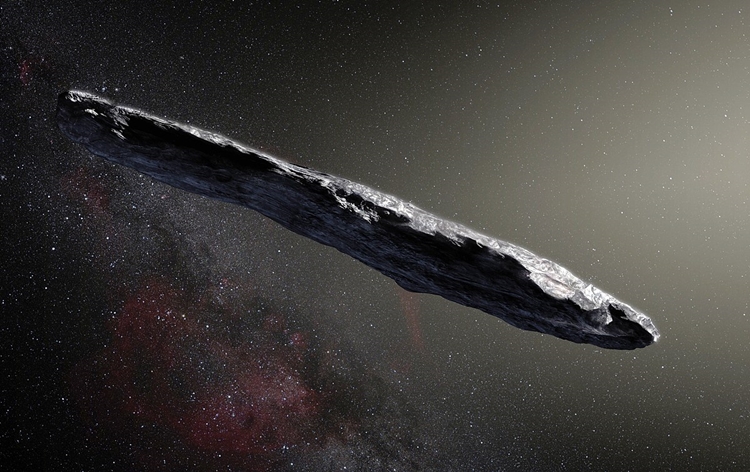
Let’s just start with the story that brought this debate back into the news. Avi Loeb, chairman of Harvard’s astronomy department, said some extraordinary things pretty matter of factly to Haaretz:
”We have no way of knowing whether it’s active technology, or a spaceship that is no longer operative and is continuing to float in space. But if Oumuamua was created together with a whole population of similar objects that were launched randomly, the fact that we discovered it means that its creators launched a quadrillion probes like it to every star in the Milky Way…I think it’s just a fishing expedition.”
Loeb is talking about the famed object that just passed through our solar system that looks something like this.

The Harvard astronomy department published a paper asserting that Oumuamua could be technology that we are working on, called a “solar sail.” It’s actually possible to propel an object through space using light. In 2016, Loeb teamed with Stephen Hawking and others to create Breakthrough Starshot, an initiative designed to create solar sails that can travel one-fifth the speed of light in order to explore our neighboring solar system, Alpha Centauri.
How Can Aliens Not Exist?
Robert Frost, Instructor and Flight Controller at NASA, laid out the math from the Kepler telescope on how many stars are like our sun with at least one planet that’s similar to Earth: 19,000,000,000,000,000,000,000.
That’s nineteen sextillion.
Let’s use Earth as an example of the odds of life like ours happening. It has been around for 4.5 billion years. All of recorded human history is about 5,000 years, which means that for about 0.0001% of Earth’s existence, life that is capable of eventual space exploration has existed.
One Earth-like planet with life capable of space exploration divided by 19 sextillion?
0.0000000000000000000005%
please let’s all just grow up and admit aliens are real
— Brandy Jensen (@BrandyLJensen) January 14, 2019
Aliens are real, folks, and the chair of Harvard’s astronomy department seemed to basically come right out and say it in this interview with Haaretz. Not to mention, we were kind of already told this. Because Trump has melted our collective brains, we’ve all forgotten about the most extraordinary report the New York Times has ever published:
Under Mr. Bigelow’s direction, the company modified buildings in Las Vegas for the storage of metal alloys and other materials that Mr. Elizondo and [government] program contractors said had been recovered from unidentified aerial phenomena.
While there are plenty of concrete reasons to be skeptical of this report, the lead author of the story, Helene Cooper, has a Pulitzer Prize. The New York Times would not have published this without going through its most thorough vetting process, and they also provided video taken by the military of objects traveling at extraordinary speeds. This report isn’t bunk, just confusing.
Is it really so crazy to believe that civilizations like ours exist throughout the infinite expanse of the universe? If we’re here, the math says that it’s likely that others are too. Our species is not as primitive as our politics makes us seem. In 2013, Voyager 1 became the first human-made object to leave our solar system. We are already something of an interstellar species sending probes throughout space, and we will perhaps provide other solar systems with our own version of Oumuamua one day.
And that is what the chair of Harvard’s astronomy department seems to believe we may have just witnessed: an alien probe sent near/towards our solar system. If that is the case, it gives even more credence to expert testimony like this:
Star & Stripes quoted former Air Force Capt. Robert Salas, who was at Malmstrom Air Force Base in Montana in 1967 when 10 ICMs he was overseeing suddenly became inoperative – at the same time base security informed him of a mysterious red glowing object in the sky.
Why is this subject so taboo in America when the scientific community cites unfathomable figures like the 19 sextillion possible Earth-like planets? France opened their files on UFOs in 2007. The UK did too in 2013.
The reason is because there has been a concerted effort made by the powers that be to restrict debate on this topic—but it wasn’t always that way—so you cannot help but wonder why the American government is like this. When the incident in Roswell, New Mexico first happened in 1947, the Roswell Army Air Field came right out and said that they recovered a “flying saucer,” before the army backtracked to the familiar “weather balloon” excuse two days later.

In 1969, the government closed the initiative they launched to study UFOs—Project Blue Book—that is the subject of infinite conspiracy theories thanks to its uncertain demise and the expansive criticisms made about it by consultants on the project like UFO skeptic-turned-believer Dr. Allen J. Hynek. Perhaps if the United States government was less secretive and more open on this topic like the French government, we would have a more reasoned debate about unidentified objects that some military leaders have said demonstrate both a fervent interest in our nuclear arsenal and the ability to completely control it. Instead, the subject of aliens is so traditionally taboo in this country that you cannot write about it without coming off like a crank, but given the litany of recent scientific discoveries, I like my odds of this hot take being correct.
Jacob Weindling is a staff writer for Paste politics. Follow him on Twitter at @Jakeweindling.